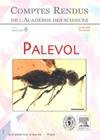New insights into the fossil record of the turtle genus Chelus Duméril, 1806 including new specimens with information on cervicals and limb bones
IF 1.3
4区 地球科学
Q3 PALEONTOLOGY
引用次数: 0
Abstract
Matamata turtles (Chelus Duméril, 1806) are composed of two extant species, Chelus fimbriata Schneider, 1783 and Chelus orinocensis Vargas-Ramírez, Caballero, Morales-Betancourt, Lasso, Amaya, Martínez, Silva-Viana, Vogt, Farias, Hrbek, Campbell & Fritz, 2020, inhabitants of the main freshwater drainages of northern South America. The systematics and palaeobiogeography of Chelus is still unresolved. Here, we describe several new fossil specimens from the Late Miocene of Urumaco (Venezuela) and Tatacoa (Colombia). The fossils are mostly complete, articulated shells that allow reestablishing validity of two extinct taxa, Chelus colombiana Wood, 1976 and Chelus lewisi Wood, 1976. One of the specimens of C. lewisi from Urumaco represents the first record within the genus for which autopodial bones (a left manus) and additional limb bones are preserved together with ashell, demonstrating evolutionary conservatism in limb anatomy for the genus. The specimen comes from the Socorro Formation, representing the earliest so far known record of Chelus for the Urumaco sequence. Additionally, one specimen from Tatacoa is the first fossil for which cervical and pectoral girdle elements are preserved. Phylogenetic analysis supports the existence of two separate clades inside of Chelus, one formed by the extinct species and the other by the extant ones.对海龟属(Chelus Duméril,1806 年)化石记录的新认识,包括带有颈椎和四肢骨信息的新标本
马塔马塔龟(Chelus Duméril,1806 年)由两个现存物种组成,分别是 Chelus fimbriata Schneider,1783 年和 Chelus orinocensis Vargas-Ramírez、Caballero、Morales-Betancourt、Lasso、Amaya、Martínez、Silva-Viana、Vogt、Farias、Hrbek、Campbell & Fritz,2020 年,它们是南美洲北部主要淡水流域的居民。Chelus的系统学和古生物地理学仍未解决。在此,我们描述了来自乌鲁马科(委内瑞拉)和塔塔科阿(哥伦比亚)中新世晚期的几件新化石标本。这些化石大多是完整的铰接贝壳,可以重新确定两个已灭绝类群的有效性:Chelus colombiana Wood, 1976 和 Chelus lewisi Wood, 1976。其中一个来自乌鲁马科的 C. lewisi 标本是该属中第一个自桡骨(左手腕骨)和其他肢骨与外壳保存在一起的记录,表明该属在肢体解剖学方面的进化保守性。该标本来自索科罗地层,是迄今所知乌鲁马科序列中最早的螯足类记录。此外,来自 Tatacoa 的一个标本是第一个保存有颈椎和胸腰椎元素的化石。系统发生学分析表明,螯虾科有两个独立的支系,一个由已灭绝的物种组成,另一个由现存的物种组成。
本文章由计算机程序翻译,如有差异,请以英文原文为准。
求助全文
约1分钟内获得全文
求助全文
来源期刊

Comptes Rendus Palevol
地学-古生物学
CiteScore
2.10
自引率
0.00%
发文量
39
审稿时长
17.6 weeks
期刊介绍:
Comptes Rendus Palevol is a fully electronic and peer-reviewed journal, with a continuous publication stream, devoted to palaeontology, prehistory and evolutionary sciences. It publishes original research results, in French or English, in the following domains: systematic and human palaeontology, prehistory, evolutionary biology and macroevolution, and history of sciences. Thematic issues may also be published under the responsibility of a guest editor. All articles published in Comptes Rendus Palevol are compliant with the different nomenclatural codes. A copyright assignment will be signed by the authors before publication.
 求助内容:
求助内容: 应助结果提醒方式:
应助结果提醒方式:


